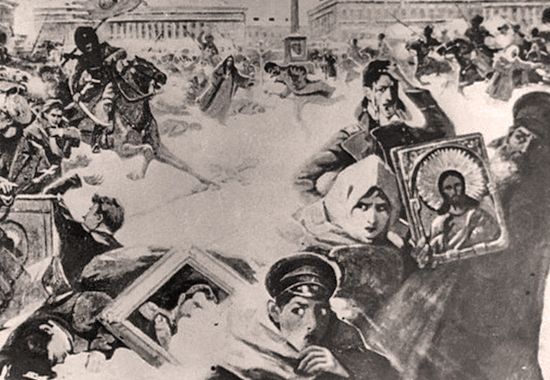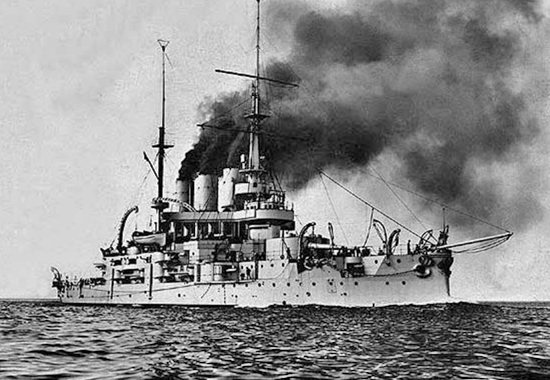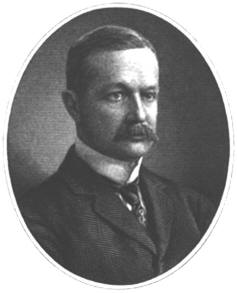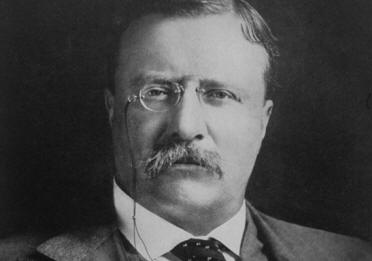|

BLOODY SUNDAY IN SAINT PETERSBURG
Russian History 1905
How to Take Power From a Tsar
The Russian Revolution of 1905 is
sometimes called the First
Russian Revolution.
|
|
In this case, the term Second
Russian Revolution refers to the Russian Revolution of 1917.
Then again, the term First Russian
Revolution can also refer to the Russian March (February)
Revolution of 1917.
In that case, the term Second
Russian Revolution refers to the Russian November (October)
Revolution of 1917.
Was the Russian Revolution of 1905 a success?
Impact of the Russian Revolution of 1905
From the viewpoint of a
revolutionary, the Russian Revolution of 1905 was rather a
disappointment because it didn't seem
to have changed anything of great consequence.
However, the Russian Revolution of 1905
paved the way for the
 Russian Revolution of 1917, the one that
really made a difference. Russian Revolution of 1917, the one that
really made a difference.
What were the background issues of the Russian Revolution of 1905? |
Causes of the Russian Revolution of 1905
The citizens of the Russian
Empire were not satisfied with their social and political situation.
The Facts:
-
The
 zemstvos had been created back in
1864 to assist the government in case of emergencies. However, these
institutions couldn't improve the general situation on a larger
scale. Instead, they became breeding grounds for organized
discontent.
zemstvos had been created back in
1864 to assist the government in case of emergencies. However, these
institutions couldn't improve the general situation on a larger
scale. Instead, they became breeding grounds for organized
discontent.
-
In 1861, and under
 Alexander II, the serfs had
been liberated.
Alexander II, the serfs had
been liberated.
 What is a serf?
What is a serf?
Although this had changed their legal status,
it left
the people in poverty and despair. Alexander couldn't keep the country out of
repression and he himself ended up a victim. He was assassinated in
1881.
-
Russia then suffered the
Great Famine
of 1891-1892. People had nothing to lose anymore, the
essential ingredient for
any revolution.
-
 Nicholas II, Russia's Czar
since 1894, didn't bring about any notable changes. Moreover, to concerned citizens he didn't
appear
to be overly troubled by the people's grievances.
Nicholas II, Russia's Czar
since 1894, didn't bring about any notable changes. Moreover, to concerned citizens he didn't
appear
to be overly troubled by the people's grievances.
Therefore, many subjects thought Czar Nicholas II to be an incompetent
head of state. But there was nothing anybody could do about it because
he ruled Russia as an autocrat. Nicholas was the Emperor, the
absolute ruler.
 By the
way, is it Czar, Tsar, or Tzar?
By the
way, is it Czar, Tsar, or Tzar?
What was the objective of the Russian Revolution of 1905?
The Goal of the Russian Revolution of 1905
The initial aim of the
Russian Revolution was to get rid of
 Nicholas II, not necessarily to
get rid of the monarchy altogether.
Nicholas II, not necessarily to
get rid of the monarchy altogether.
What were the highlights of the Russian Revolution of 1905?
The
Russian Revolution of 1905
- Timeline of Major Events
January 22, 1905 (January 9, 1905
 Old Style)
Old Style)
A peaceful mass demonstration composed of approx. 150,000 workers in
 St. Petersburg, led by priest
St. Petersburg, led by priest
 Georgy Apollonovich Gapon, turns
slaughter fest when police open fire, killing about 130 people in the crowd and
wounding hundreds.
Georgy Apollonovich Gapon, turns
slaughter fest when police open fire, killing about 130 people in the crowd and
wounding hundreds.
What had happened?
The workers shuffled down the streets
of Saint Petersburg direction Winter Palace, the Czar's home address,
to protest in front of his residence against low wages and poor working conditions.
Armed troops blocked their way and ordered the crowd to disperse.
The crowd did not break up. Shortly after it hailed bullets on the demonstrators who, by the way, were
unarmed and carried portraits of
 Czar Nicholas II
and religious icons. At their next rally, they left these items at
home. Czar Nicholas II
and religious icons. At their next rally, they left these items at
home.
This day became known as
Bloody Sunday or Кровавое воскресенье,
which, for the linguistically inclined, can be pronounced Krovavoye Voskresenye.
The Impact of Bloody Sunday
Naturally, the workers were outraged after
this massacre. The
Liberals wanted the Czar to sign constitutional reforms, the
armed forces wanted something worth fighting for (and worth shooting at,
for that matter.) The ethnic
minorities were ready for their respective independences, the peasants demanded
redistribution of land, and of course, the students thought the situation
blew.
More strikes and more riots were in
the air, and not only in St. Petersburg.
In short, Bloody Sunday encouraged strikes and uprisings all across
the Empire. The Russian Revolution of 1905 had begun.
June 27, 1905
(June 14, 1905
 Old Style)
Old Style)
Mutiny on the battleship Potemkin in the Black Sea. The
revolution had spread to the navy and Sergei Eisenstein will get
inspired to make a movie out of this in 1925.

BATTLESHIP POTEMKIN
Photo taken in 1906. By then
the ship was renamed to Saint Panteleimon.
June 28, 1905
(June 15, 1905
 Old Style)
Old Style)
The battleship Potemkin arrives in the port of Odessa. The
people of Odessa wait for the sailors to lead them in their revolt,
but the sailors drag their feet.
September 1, 1905
(August 19, 1905
 Old Style)
Old Style)
Seeing that the unrest spreads with remarkable speed,
 Nicholas has to come up with
something to restore order. Nicholas issues his
August Manifesto.
Nicholas has to come up with
something to restore order. Nicholas issues his
August Manifesto.
Here is the text of the August
Manifesto.
The empire of Russia is formed and
strengthened by the indestructible union of
the Tsar with the people and the people with
the Tsar. This concord and union of the Tsar
and the people is the great moral force
which has created Russia in the course of
centuries by protecting her from all
misfortunes and all attacks, and has
constituted up to the present time a pledge
of unity, independence, integrity, material
well-being, and intellectual development in
the present and in the future.
In our manifesto of February 26, 1903, we
summoned all faithful sons of the fatherland
in order to perfect, through mutual
understanding, the organization of the
State, founding it securely on public order
and private welfare.
We devoted ourselves to the task of
coordinating local elective bodies (zemstvos)
with the central authorities, and removing
the disagreements existing between them,
which so disturbed the normal course of the
national life. Autocratic Tsars, our
ancestors, have had this aim constantly in
view, and the time has now come to follow
out their good intentions and to summon
elected representatives from the whole of
Russia to take a constant and active part in
the elaboration of laws, adding for this
purpose to the higher State institutions a
special consultative body entrusted with the
preliminary elaboration and discussion of
measures and with the examination of the
State Budget.
It is for this reason that, while preserving
the fundamental law regarding autocratic
power, we have deemed it well to form a
Gosoudarstvefinaia Duma (i.e. State Council)
and to approve regulations for elections to
this Duma, extending these laws to the whole
territory of the empire, with such
exceptions only as may be considered
necessary in the case of some regions in
which special conditions obtain. . . .
We have ordered the Minister of the Interior
to submit immediately for our approbation
regulations for election to the Duma, so
that deputies from fifty governments, and
the military province of the Don, may be
able to assemble not later than the middle
of January, 1906.
We reserve to ourselves exclusively the care
of perfecting the organization of the
Gosoudarstvenriaia Duma, and when the course
of events has demonstrated the necessity of
changes corresponding to the needs of the
times and the welfare of the empire, we
shall not fail to give the matter our
attention at the proper moment.
We are convinced that those who are elected
by the confidence of the whole people, and
who are called upon to take part in the
legislative work of the government,
will show themselves in the eyes of all
Russia worthy of the imperial trust in
virtue of which they have been invited to
cooperate in this great work; and that in
perfect harmony with the other institutions
and authorities of the State, established by
us, they will contribute profitably and
zealously to our labors for the well-being
of our common mother, Russia, and for the
strengthening of the unity, security, and
greatness of the empire, as well as for the
tranquility and prosperity of the people. .
. .
Given at Peterhof on the nineteenth day of
August, in the year of grace 1905, and the
eleventh year of our reign.
Nicholas
September 5, 1905
(August 23, 1905
 Old Style)
Old Style)
Russia signs the
 Treaty of Portsmouth and the
Treaty of Portsmouth and the
 Russo-Japanese War is officially over. However, the troops
can't get
back home right away because the railway workers are on strike.
Russo-Japanese War is officially over. However, the troops
can't get
back home right away because the railway workers are on strike.
The Treaty of Portsmouth was a
masterstroke by the former Minister of Finances Sergei Witte
who was made Count for his diplomatic victory.
October 30, 1905 (October 17,
1905
 Old Style)
Old Style)
A general strike put Russia's main cities in a deadlock.
Pressured by the mass movement,
following the advice of Count Sergey Yulyevich Witte,
and convinced by his cousin Nikolai
Nikolayevich,
 Nicholas II issues his
October
Manifesto this evening. Nicholas II issues his
October
Manifesto this evening.
In this manifesto he promises civil liberties, such as the
freedom of speech and the freedom of assembly. He also promises the
right to vote for a parliament whose approval would be necessary
to pass laws, the
 Duma.
Duma.
Here is the text of the October
Manifesto.
We, Nicholas II,
Emperor and Autocrat of All the Russians,
Tsar of Poland, Grand Duke of Finland, etc.
etc., declare to all our loyal subjects:
The disturbances and unrest in St
Petersburg, Moscow and in many other parts
of our Empire have filled Our heart with
great and profound sorrow. The welfare of
the Russian Sovereign is inseparable from
the welfare of His people, and national
sorrow is His sorrow. The present
disturbances could give rise to profound
disaffection among the masses, presenting a
threat to the unity and integrity of Our
State.
The oath which We took as Tsar compels Us to
use all Our strength, intelligence and
authority to put a speedy end to this unrest
which is so dangerous for the State. The
relevant authorities have been ordered to
take measures to deal with direct outbreaks
of disorder and violence and to protect
people who only want to go about their daily
business in peace. However, view of the
needed for successful implementation of
earlier measures aimed at pacifying the
country, we have decided that the work of
the agencies of government must be
coordinated. We have therefore ordered the
government to take the following steps in
fulfillment of our unbending will:
-
Fundamental civil
freedoms will be granted to the
population, including real personal
inviolability, freedom of conscience,
speech, assembly and association.
-
Without halting
the elections that have already been
scheduled, participation in the Duma
will be granted to those classes of the
population which are at present deprived
of voting powers (insofar as is possible
in the short period before its
convocation.)
Further development of a universal
franchise will be left to the newly
established legislature (i.e. according
to the law of August 6, 1905, to the
Duma and Council of State.)
-
It is established
as an unshakeable rule that no law can
come into force without its approval by
the State Duma and representatives of
the people will be given the opportunity
to take real part in the supervision of
the legality of authorities appointed by
Us.
We call on all true
sons of Russia to remember their duty to the
homeland, to help put a stop to this
unprecedented unrest and, together with
this, to devote all their strength to the
restoration of peace and quiet in our native
land.
Issued at Peterhof on the 17th of October in
the year of Our Lord 1905, in the eleventh
year of Our reign.
Nicholas II
This manifesto was too specific to
reverse. The people who weren't stunned stiff by
Nicholas' sensational concessions were busy preparing for the new
Duma elections.
Even though there were some
revolutionists who drew attention to the fact that a promise is just
a promise and not yet the real thing, the moment had passed. The
manifesto had taken the oomph out of the revolution.
November 1, 1905 (October 19,
1905
 Old Style)
Old Style)
Witte becomes Russia's first
President of the Council of Ministers, aka Prime Minister. However,
this post did not really include the authority that would be
normally associated with a prime minister. Witte will resign on
April 27, 1906. His resignation will be accepted on May 5, 1906.
What happened after October / November
1905?
Russia After the
Revolution of 1905
Some fighting continued but most people
returned to their jobs while the Tsar was busy sifting out, tracking
down, and arresting the leaders
of the revolution,
 Leon Trotsky being one of them. Leon Trotsky being one of them.
Although the revolution was more or less
over by the end of 1905, unrest continued until 1907, especially in
rural areas.
Did the October Manifesto really
change anything?
The Effects of the
October Manifesto
After his 1905 promise to let the people
have a say in the country's lawmaking,
 Nicholas II followed up
by issuing the Fundamental Laws in April 1906. Nicholas II followed up
by issuing the Fundamental Laws in April 1906.
Officially, these laws
were drafted to restore order. Unofficially, it was Nicholas' damage
control tool
for the trouble his October Manifesto had caused him. By means of
the Fundamental Laws of 1906, Nicholas cut the power of the Duma.
Terminology Introduced by the Russian Revolution of 1905
What is a Soviet?
The Russian Revolution of 1905 and the Soviet
The Revolution of 1905 introduced the Soviet,
which was the revolution's panel of leaders. The term later applied
to elected councils in the USSR.
The word soviet stems from the Russian
word sovet, meaning governing council.
Who were the Black Hundred?
The Russian Revolution of 1905 and the Black Hundreds
Various groups of
counter-revolutionaries with the anti-Semitic twist. The
Black Hundreds popped on the map
during the Revolution of 1905 and harassed wholeheartedly in the
name of God, Tsar, and the extreme right-wing until 1914.
What is a Duma?
The Russian Revolution of 1905 and the Duma
Duma is the Russian word for
deliberation. When used in the context of an organization, the
word duma refers to a group of people in Russian history, who
acted as advisers to ruling princes or later, after
 Catherine the
Great had reorganized local administration, as a town's
council. These municipal councils were in effect until
1917.
Catherine the
Great had reorganized local administration, as a town's
council. These municipal councils were in effect until
1917.
If spelled with a capital D and referred
to as the Duma the word is short for the Russian term
Gosudárstvennaya Dúma, which means State Assembly. This
Duma is the one that was promised by
 Nicholas II in his
October
1905 Manifesto.
Nicholas II in his
October
1905 Manifesto.
What exactly is The Duma?
The elected lower house of the Russian parliament. Also called the
State Duma (as opposed to the City Duma - see above), the Duma
was in operation from 1906 until March 1917. The upper house of the
parliament was the State Council.
The Duma was elected for five years. All
in all, four dumas came together.
First Duma
May 10 - July 21, 1906 (Dissolved by Nicholas II)
 Prince Georgy Yevgenyevich Lvov was elected to this Duma.
In 1917, Lvov will become the first Prime Minister of the Provisional
Government.
Prince Georgy Yevgenyevich Lvov was elected to this Duma.
In 1917, Lvov will become the first Prime Minister of the Provisional
Government.
When the First Duma was dissolved
by the imperial government, about 200 of its former members
traveled across the border to meet in Vyborg, Finland, where
many of them signed the
 Vyborg Manifesto.
Vyborg Manifesto.
Second Duma
March 5 - June 16, 1907 (Dissolved by Nicholas II)
Third Duma
November 14, 1907 - June 22, 1912 (Normal term)
Fourth Duma
November 28, 1912 - March 11, 1917 (This Duma demanded Nicholas'
abdication and became the Provisional Government in 1917)
In 1993, by the way, the Russian
Federation went back to the roots and decided to call their lower
house of parliament again State Duma. The things you wanna write
Nicholas a postcard about...
What else?
Russian Revolution of 1905 - Trivia
The U.S. ambassador to Russia from
1905 until 1907 was George V.L. Meyer.

GEORGE V.L. MEYER -
AMBASSADOR TO RUSSIA
U.S. Department of State
U.S. President at the time was
Theodore Roosevelt, in office from 1901-1909.

THEODORE ROOSEVELT -
PRESIDENT OF THE U.S. 1901-1909
USA.gov
More History
|